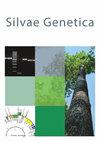基于反转录转座子的标记揭示了突尼斯开心果物种根据地理来源和繁殖状况的重新划分
IF 1
4区 农林科学
Q3 FORESTRY
引用次数: 1
摘要
反转录转座子的运动被认为是进化过程和物种形成的一个重要因素,也是遗传变异的一个来源。利用9个反转录转座子间扩增多态性(IRAP)标记对突尼斯开心果进行遗传多样性和群体结构分析。结果得到86个扩增子,其中98.15%为多态性扩增子。有效等位基因数(Ne)、香农信息指数(I)和Nei遗传多样性(H)的平均值分别为1.529、0.478和0.310。种群内平均遗传多样性(Hs)为0.24,总遗传多样性(Ht)为0.3。突尼斯开心果居群具有较高的遗传分化(Gst =0.275)和基因流(Nm = 1.888)。分子方差分析(AMOVA)表明,种群内变异非常大(83%)。利用邻联法(NJ)和主坐标分析法(PCoA)进行的系统发育树分析表明,突尼斯品种的分类与树木的性别无关,但取决于它们的地理来源和育种状况。基于模型的贝叶斯聚类(STRUCTURE)证实了这些观察结果。逆转录转座子间扩增多态性标记在种间水平上具有显著的信息性。我们的研究结果将对培育具有发达化学和园艺特征的新开心果基因型具有重要意义。本文章由计算机程序翻译,如有差异,请以英文原文为准。
Retrotransposon-based markers revealed a repartition depending on geographical origin and breeding status of Tunisian pistachio species
Abstract Retrotransposon movements are considered to be an important factor in evolutionary processes and speciation as well as a source of genetic variation. In order to analyze genetic diversity and population structure in Tunisian pistachio species, nine inter-retrotransposon amplified polymorphism (IRAP) markers were used. As a result, eighty-six amplicons were produced among which 98.15 % were polymorphic. Mean numbers of the effective number of alleles (Ne), Shannon’s information index (I) and Nei’s genetic diversity (H) were respectively 1.529, 0.478, and 0.310. The average within-population genetic diversity (Hs) was 0.24 and the total diversity (Ht) was 0.3. The Tunisian pistachio populations exhibited high genetic differentiation (Gst =0.275) and gene flow (Nm = 1.888). The Analysis of Molecular Variance (AMOVA) indicated that variation was very high within populations (83 %). Phylogenetic tree using neighbor- joining (NJ) method and Principal Coordinates Analysis (PCoA) depicted that groupings of Tunisian varieties were made independently of the sex of the trees, but depending on their geographical origin and their breeding status. The modelbased Bayesian clustering (STRUCTURE) confirmed these observations. The inter-retrotransposons amplification polymorphism markers were significantly informative at the interspecific level. Findings reported in our study will be essential toward breeding for new pistachio genotypes with developed chemical and horticultural features.
求助全文
通过发布文献求助,成功后即可免费获取论文全文。
去求助
来源期刊

Silvae Genetica
农林科学-林学
CiteScore
2.20
自引率
10.00%
发文量
10
审稿时长
3 months
期刊介绍:
Silvae Genetica is an international peer reviewed journal with more than 65 year tradition and experience in all fields of theoretical and applied Forest Genetics and Tree breeding. It continues "Zeitschrift für Forstgenetik und Forstpflanzenzüchtung" (Journal of Forest Genetics and Forest Tree Breeding) founded by W. LANGNER in 1951.
 求助内容:
求助内容: 应助结果提醒方式:
应助结果提醒方式:


